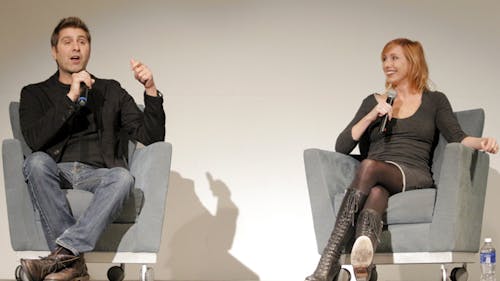MythBusters assistants talk making of the TV series

For their first myth, “MythBusters” asked Kari Byron to get a 3-D scan of her butt to test a myth. They wanted to know whether someone could get stuck on an airplane toilet seat.
Byron started out at the popular science entertainment television program with an internship. She wanted to be a sculptor and visited Jamie Hyneman, who worked with props and special effects, asking him to let her work for free.
“MythBusters” assistants Byron and Tory Belleci visited the Busch Campus Center last night to discuss the show’s impact on making science popular.
The hosts for the night began with a clip that featured scenes from the show, ranging from explosions to car accidents.
Belleci soon learned his new job would include plenty of action — and gore.
On his first day, they tested the chicken cannon myth: Can a chicken crack a pane of glass?
“There were chicken guts ... just sprayed over the walls and the ceiling,” he said. “We were scraping chicken guts off the roof.”
Belleci has a history with explosions and disasters. At 12 years old, he decided to build a flamethrower in his backyard and hit the side of his house while his parents were at work.
“Now there’s this big black char on the side of the house … so I bought some paint the color of the house and painted it over,” he said. “My parents didn’t find out until I told the story on some talk show.”
Belleci has worked on movies such as “The Matrix” and “Scooby-Doo.” He had just finished working on the first “Star Wars” movie when Hyneman and Adam Savage, the stars of “MythBusters,” left to do a pilot. A year later, they called to ask him to work in the background.
Belleci said they soon learned — when in doubt, blow it up. They once filled a cement truck with 850 pounds of explosives on his birthday.
The cement truck literally turned to dust, and the explosion caused a shockwave they felt from a mile away.
Byron said “MythBusters” did not originally aim to focus on science, rather to test urban legends using a science background.
“We’re not scientists, but we play them on television,” Belleci said.
The whole gag of the show was that none of them knew what they were doing, she said. They found it exciting to see children eager to learn about science through the show.
Belleci loves when something unexpected happens. For example, she discussed the myth about elephants being afraid of mice, which they did not expect to be real.
But when they visited Africa and hid mice among wild elephants, the elephants began to run away.
Byron said another surprise was when the bull in a China shop myth proved totally wrong. The bull gracefully walked among the shelves.
For the deep-sea diver myth, Belleci said they wanted to test whether divers could have their head pulled into their helmet, and decided to make a new “Frankenstein.” He had to go through the awkward process of finding body pieces and sewing them together in a freezer.
“We have a weird relationship with the butcher,” Byron said.
Belleci called the final result “He-man.” Exactly as the myth said, when the pressure valve was released, the body began to squeeze into the helmet. As they celebrated, the flow of gas coming from the rotten body ran up to meet them.
The two accused each other of being bad practical jokers. While testing whether a tongue could get stuck to a frozen pole, they had to collect saliva to paint on a pig’s tongue.
They put it in the microwave to heat to human body temperature.
“We walked it through the shop and everybody was gagging,” he said.
What Byron was unaware of was that Belleci had a beaker nearly identical to the saliva beaker.
She drank out of it, and Byron promptly threw up.
To choose myths, Byron said they looked at several criteria, such as whether a myth is testable.
Byron said she continued sculpting after working with “MythBusters.” She now makes cautionary sculptures for her daughter, like boogie monsters to prevent her from picking her nose.
Byron said her favorite myth was whether someone’s pants could spontaneously combust after exposure to fertilizer. She was in awe of the science of the experiment and finding it out it was true.
Belleci’s favorite myth was a sawdust cannon that looked like a gas bomb. They proved the myth and continued to test the cannon with 600 pounds of nondairy creamer.
“All of a sudden, the sky caught on fire,” he said.
It seemed like a devil face looming over them, Byron said.
Carey Loch, associate director of programs for Student Life, said the event was a collaboration between the Rutgers University Programming Association, GeekWeek and SciFest.



